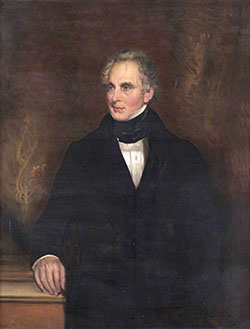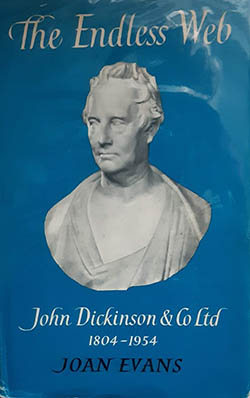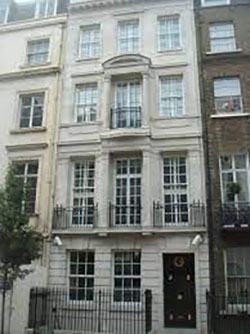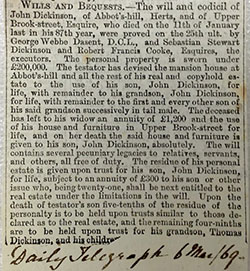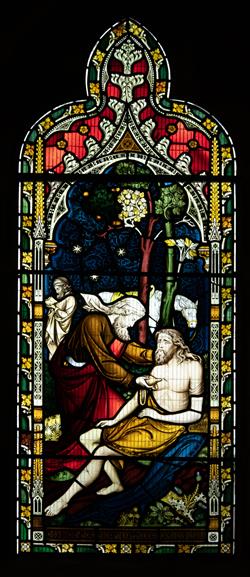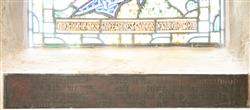John DICKINSON 1782 - 1869
(Portrait by unknown artist)
The eldest of ten children of Captain Thomas Dickinson RN (1754–1828) and Frances de Brissac (1760–1854).
Born 17th October 1782, Middlesex
Died 11th January 1869, 39 Upper Brook St, London W1
Married Ann GROVER 1789 - 1874 on 5th September 1810, at Hemel Hempstead, Hertfordshire.
Seven children were born to John DICKINSON and Ann GROVER
John Moody DICKINSON
1811 - 1812
John Henry DICKINSON
1812 - 1813
Frances Elizabeth DICKINSON
1814 - 1881
m. Frederick William PRATT-BARLOW 1815 - 1883
(eight children)
John DICKINSON
1815 - 1876
m. Alicia BICKNELL 1828 - 1875
(three children)
Samuel DICKINSON
1820 - 1826
William DICKINSON
1821 - 1832
1826 - 1858
m. John EVANS K.C.B. 1823 - 1908
Harriet and John were first cousins.
Poison
The tragedy of John and Ann’s wedded life lay in the deaths of four young sons. The sad truth is that those who died were the victims of their mother’s sense of duty and her belief in the medical lore of the day. However young they were, and whatever was wrong with them - a cold in the head, a liver chill, a headache, a fit of bad temper, a feverish attack, a broken collar bone - she conscientiously dosed them with calomel. If there was nothing wrong, she gave a precautionary dose every few days.
Calomel is a cumulative poison, and few survived.
Source: The Endless Web Joan Evans.
Business Partnerships and Children
John, the only surviving son, had no interest in his father’s paper making business and refused to be drawn into management. The daughters being creatures of their time, no matter how able, were not expected to shoulder responsibility at executive level.
However, Harriet married her first cousin John EVANS who was also John Dickinson’s nephew. He had been working for his uncle for some time and was made partner of the firm on the occasion of his marriage to Harriet.
Frances Elizabeth married a solicitor, Fredrick William PRATT BARLOW, who was soon drawn into partnership.
Although women were, generally, not expected to head up large business concerns, one woman of the family certainly played her part. This was John’s mother, Frances de Brissac. She had an excellent mathematical mind and regularly checked on the accounts, poring over ledgers. If anyone could spot inaccuracies - she could.
Papermaker
John DICKINSON founded a giant business empire employing many thousands of people world-wide at its peak.
He started his working life by training as a stationer in the City of London, becoming enrolled in the Worshipful Company of Stationers and Newspaper Makers at Stationer’s Hall in 1804. After a long and successful career he became Master of the Company in 1857.
A keen businessman and of an inventive practical nature he must have been frustrated by the myriad of small paper mills with which he did business and realised that to be efficient he would have to have the whole process under his own control. At that time each mill was under individual ownership using their own methods of making each sheet of paper individually; a slow and expensive process often with variable quality.
He was the holder of many patents relating to paper and its use. His first was for a non-smouldering paper for use in rifles called Cartridge Paper; said to have been particularly helpful to Wellington’s Peninsular campaign and at Waterloo by increasing the British firing rate whilst simultaneously reducing premature firing accidents. His next patent, in 1809, was for a means of making paper in a continuous sheet in what has become known as the Cylinder Mould machine, an alternative process to the already well established Fourdrinier machine. He was well acquainted with the continuous web of making silk material and adapted this knowledge.
Dickinson arranged financing to buy Apsley Mill in 1807 and the nearby Nash Mill in 1811 where he installed and developed machines of his own design as well as those using the Fourdrinier patent. By the 1815, Dickinson’s mills were producing some of the best and most consistent paper in the country.
Dickinson was involved with the development of the Penny Post, producing a paper containing silk threads for security purposes. He also patented a method of slitting paper with sharp bevelled wheels, still used on machines today and from which office guillotines in common use have evolved. In addition to his factories at Apsley and Nash he built two brand new mills at Home Park and Croxley in 1825 and 1828. Other sites in Manchester, Liverpool and elsewhere were created for distribution.
Transportation of goods and coal occupied him in the early days and litigation with the Grand Junction Canal Company resulted in the re-routing of the canal closer to his Apsley and Nash Mills. He successfully tendered for the building work of locks and wharves required for the diversion in 1818.
During his career folded envelopes were developed and a wide variety of uses for paper and paper products explored. In 1858 John Dickinson retired handing over the running of the business to his nephew, John EVANS 1823 - 1908.
Source: Frogmore Paper Mill, Apsley, Hemel Hempstead HP3 9RY
For a full account of John DICKINSON & Co. Ltd.,
see THE ENDLESS WEB by Joan Evans, 1955.
Publisher: Jonathan Cape.
Death
John Dickinson died in Mayfair on 11 January 1869 having refused to call in his doctor on the grounds that he was too ill to see anyone!
Memorial Window
Visited April 2023...
South wall St Lawrence church, Abbots Langley, Herts
Zoom in, and over expose, we read the following inscription:
To the Glory of God and to the beloved memory of JOHN DICKINSON FRS
Of Abbots Hill, in this Parish Esq who was born 29th March 1782
died 11th Jany 1869, and was buried in Kensal Green Cemetery
This window is dedicated by his Widow Ann, daughter of Harry Grover, of
The Bury, Hemel Hempstead Esq.
